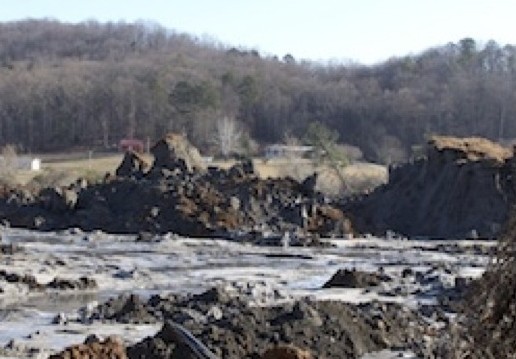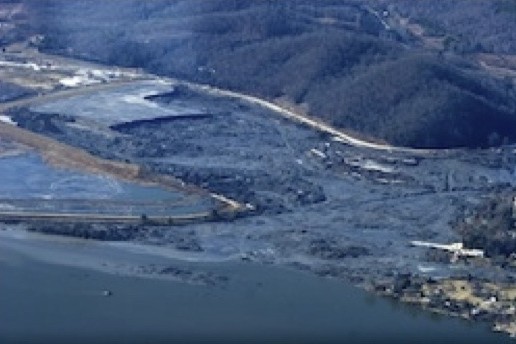 The coal ash that spilled from a failed impoundment at TVA’s Kingston plant in eastern Tennessee filled the Emory River, creating huge mounds of toxic waste that locals called ashbergs.Photo: Sarah McCoinA special Facing South investigation.
The coal ash that spilled from a failed impoundment at TVA’s Kingston plant in eastern Tennessee filled the Emory River, creating huge mounds of toxic waste that locals called ashbergs.Photo: Sarah McCoinA special Facing South investigation.
Shortly before 1 a.m. on Dec. 22, 2008, a dike holding back an 84-acre pond of wet coal ash at the Tennessee Valley Authority’s Kingston plant near Harriman, Tenn. ruptured and collapsed following weeks of heavy rains. A billion gallons of muddy, gray coal ash loaded with arsenic, lead and other contaminants poured across the nearby Emory River to the neighborhood along Swan Pond Road.
The toxic tidal wave hit suddenly, taking sleeping residents by surprise. It damaged a total of 42 homes, pushing one house completely off its foundation and rendering three others uninhabitable. It tore down trees, pushed boats off docks, washed out a road and a railway, ruptured a major gas line, broke a water main, and ripped down power lines. No people died in the disaster, though a dog that had been tied up in the yard of one house was buried by the coal ash and couldn’t be rescued in time.
Some residents didn’t realize what had happened until after dawn, when they awoke to a landscape that one survivor described as looking like “a movie scene on the ugliest planet imaginable.” The sludge covered almost half a square mile of once-beautiful riverfront land, reaching six feet deep in places. A popular local fishing cove was filled with coal ash, the massive chunks sticking up 20 feet in the air like dirty icebergs.
Since the disaster, TVA has been scraping up the spilled ash from the land and dredging it out of the waterways, with the main channel of the Emory set to reopen this week. But the company estimates that 500,000 cubic yards of spilled ash will remain in the river because workers simply can’t get it all out. And while the EPA previously advised people against swimming, tubing and other activities near the disaster site because of the risk of contact with toxic ash, the agency and state officials are now saying that the remaining coal ash presents minimal health risks — though they’re still recommending that people wash off after leaving the water.
The effects of the Kingston disaster will be felt for a long time. How could something like this happen? And could a similar coal ash tragedy strike elsewhere?
‘Appropriate safety modifications were not made’
 Problems including leaks had plagued the coal ash impoundment at TVA’s Kingston plant for years before its collapse, raising questions about why the company and state regulators failed to take action.Photo: John WathenThe catastrophic collapse at Kingston was the culmination of problems that for years had been plaguing the plant’s impoundments — those massive and usually unlined holding ponds where the waste is dumped after burning coal for power. But TVA had repeatedly failed to fix those problems, and an inadequate regulatory system failed to address them.
Problems including leaks had plagued the coal ash impoundment at TVA’s Kingston plant for years before its collapse, raising questions about why the company and state regulators failed to take action.Photo: John WathenThe catastrophic collapse at Kingston was the culmination of problems that for years had been plaguing the plant’s impoundments — those massive and usually unlined holding ponds where the waste is dumped after burning coal for power. But TVA had repeatedly failed to fix those problems, and an inadequate regulatory system failed to address them.
A July 2009 report by TVA’s Inspector General found that red flags were raised as far back as 1985, when an internal memorandum written by a TVA engineer cited concerns about the stability of the Kingston coal ash storage facilities — concerns echoed in two 2004 reports by external engineering consultants hired by TVA.
The Inspector General’s report also noted that a 1987 internal TVA memorandum stated that the impoundments had become “quite high with increasing risk and consequences of a breech” and recommended more rigorous inspection standards. That led to discussions about managing the ash ponds under the company’s dam safety program, but TVA ultimately decided not to do that. On top of that, local residents had reported leaks in the dam going back as far as 2001, and the utility itself acknowledged that there had been leaks there in 2003 and 2006.
“TVA could have possibility prevented the Kingston Spill if it had taken recommended corrective actions,” according to the report. “For reasons that are still not entirely clear, appropriate safety modifications were not made.”
TVA has also drawn criticism from affected residents and environmental advocates for not being straightforward about the scale and impact of the Kingston spill. At first, the utility dramatically underestimated the amount of ash released and incorrectly claimed that no dead fish were found downstream of the disaster.
TVA described coal ash as consisting primarily of “inert material not harmful to the environment.” In reality, coal ash contains potentially harmful levels of toxic arsenic, lead, and mercury. The utility also likened the radioactive threat from the coal ash to radioactivity in table salt, even though researchers with Duke University in North Carolina found significant levels of cancer-causing radioactive elements in the ash.
TVA has even been accused of manipulating science methods to downplay water contamination caused by the spill, with evidence showing that it may have intentionally collected water samples from relatively clean spots in the Emory River. As Pennsylvania hydrogeologist Bob Gadinski told The Nation, it appears that TVA “isn’t interested in properly mapping the contaminants in that river.”
At the same time, the company created difficulties for independent researchers monitoring contamination from the spill. In December 2008 TVA police issued a warning ticket for criminal trespass to Upper Watauga Riverkeeper Donna Marie Lisenby for trying to access the spill site by kayak to take samples — though she was on a public waterway and there were no signs indicating the river was closed. Then in early 2010, TVA blocked Lisenby and other researchers from accessing an established sampling point along the Emory because they weren’t wearing hardhats and safety vests. When they asked permission to return to shore to get the equipment, TVA refused.
“It’s been a story about hiding the truth from the people, and preventing the truth tellers from being able to tell the truth,” Lisenby said.
And while TVA commissioned a study of the impoundment’s failure by the Los Angeles-based engineering firm AECOM, TVA’s Inspector General found that it designed the study in a way that minimized management’s liability and provided no lessons for the company to draw on.
The IG’s 2009 audit report said TVA’s actions seemed more focused on avoiding lawsuits than learning lessons from the disaster. As the report concluded, “TVA has urged everyone just to ‘move forward’ without further examination of what responsibility TVA management may have had for the disaster that occurred on December 22, 2008. TVA management handled the root cause analysis in a manner that avoided transparency and accountability in favor of preserving a litigation strategy.”
‘Some horrible nightmares’
 Following the collapse of the Kingston coal ash impoundment, nearby resident Pam Topmiller experienced eye problems until she and her husband installed air filters in their home.Still from a video by United Mountain DefenseAny hopes TVA had for avoiding litigation over the disaster were dashed in March 2010, when a federal judge ruled that plaintiffs in seven suits would be allowed to argue that the company was negligent in the use and maintenance of the Kingston coal ash pond. In all, more than 500 plaintiffs have filed more than 50 lawsuits against the company in connection with the spill.
Following the collapse of the Kingston coal ash impoundment, nearby resident Pam Topmiller experienced eye problems until she and her husband installed air filters in their home.Still from a video by United Mountain DefenseAny hopes TVA had for avoiding litigation over the disaster were dashed in March 2010, when a federal judge ruled that plaintiffs in seven suits would be allowed to argue that the company was negligent in the use and maintenance of the Kingston coal ash pond. In all, more than 500 plaintiffs have filed more than 50 lawsuits against the company in connection with the spill.
“This is a tremendous victory in the effort to hold TVA accountable for the severe damage it has caused to residents and the environment,” said Elizabeth Alexander, one of the attorneys representing plaintiffs suing the company. “The Court held that TVA must answer for its alleged negligence that directly led to one of the largest environmental catastrophes in our country’s history.”
The court’s decision wasn’t a complete win for the plaintiffs, as the judge ruled that they couldn’t ask for punitive damages or a jury trial. But the ruling rejected claims by TVA — a federally owned but independently financed corporation serving almost 9 million customers in seven Southern states — that it’s immune from legal action as a government agency. The court held that once a policy decision has been made, the government is accountable for its negligence in implementing it.
While the lawsuits wind through the courts, residents near the Tennessee plant continue to grapple with the lingering health risks unleashed by the disaster. TVA has bought out more than 140 property owners, but other affected residents say the utility isn’t offering them fair compensation for their property, or their property isn’t considered close enough to qualify.
The spill dumped 2.66 million pounds of 10 toxic pollutants into the Emory and nearby Clinch rivers — more than all the surface-water discharges from all U.S. power plants in 2007, according to a report from the Environmental Integrity Project. Independent tests sponsored by EIP and United Mountain Defense and conducted more than two months after the disaster found levels of some toxic metals including arsenic, cadmium, and lead exceeding Clean Water Act standards designed to protect aquatic life as well as humans who come in contact with the water.
The ash also accumulated on the land, where it can dry out and become an air pollutant — a concern since EPA found dangerously elevated levels of arsenic in coal ash samples taken from a road at the disaster site.
Residents blame the ash spill for a range of ailments they began experiencing after the disaster. Gary Topmiller and his wife, Pam, live across the river from the failed impoundment. In the months following the spill, Pam Topmiller’s eyes regularly swelled shut until the couple installed air filters in their home.
Connie Kelley, a resident of the area directly impacted by the spill, reported other problems: “Since the spill I have been having a lot of headaches, eyes burning and itching, coughing, nose bleeds and some horrible nightmares. I never had a nightmare in my life until this.”
Dumping on the disadvantaged
 Ruby Holmes lives near the Alabama landfill that’s taking the spilled ash from TVA’s disaster site in Tennessee and is concerned about the impact the dump is having on her health.Photo: John WathenThe toxic nightmares that haunt residents near TVA’s Kingston plant are now disrupting the peace of another community in Perry County, Ala. That’s where the company — with EPA’s approval — chose to dispose of the 3 million cubic yards of coal ash scraped up from the spill site.
Ruby Holmes lives near the Alabama landfill that’s taking the spilled ash from TVA’s disaster site in Tennessee and is concerned about the impact the dump is having on her health.Photo: John WathenThe toxic nightmares that haunt residents near TVA’s Kingston plant are now disrupting the peace of another community in Perry County, Ala. That’s where the company — with EPA’s approval — chose to dispose of the 3 million cubic yards of coal ash scraped up from the spill site.
For the past year, Tennessee’s toxic sludge has been shipped 320 miles south to the Arrowhead Landfill near Uniontown, Ala., a facility owned by Perry County Associates and managed by Phill-Con Services and Phillips & Jordan. TVA said it chose the site because it was accessible by train, underbid other candidates and had the capacity to handle all the ash. Under Alabama law, coal ash isn’t regulated and doesn’t have to be placed in a lined landfill like Arrowhead; however, ash from the Kingston spill is considered remediation waste and is regulated more strictly.
For Perry County, Ala., the coal ash shipments are being touted as a much-needed financial boost: The fee paid by the landfill operators is expected to increase the county’s annual budget from $4.5 million to $7.5 million.
“The economic development opportunity, along with safe environmental management practice, has put renewed hope back into a once-proud county,” Perry County Commissioner Albert Turner Jr. testified to a U.S. House committee in December 2009.
But not everyone has been so enthusiastic. Community leaders and environmental advocates pointed out that Perry County is almost 70 percent black, with more than 31 percent of its families in poverty — a classic case of environmental injustice.
The disparity is even starker when one looks at the community closest to the dump: Uniontown, Ala. is 88 percent African-American with almost half of its residents living in poverty, according to 2000 Census data. Residents called on EPA Administrator Lisa Jackson to protect them from the toxic waste.
“There’s a sense among the population that we’ve been thrown under the bus,” Robert Bamberg, a white catfish farmer and organizer of Concerned Citizens of Perry County, told the New York Times last year.
The decision to allow TVA to dump its coal ash in Perry County was among a number made by EPA Region 4 that were highlighted in a September 2009 report by Professor Robert D. Bullard, director of the Environmental Justice Resource Center at Georgia’s Clark Atlanta University. Bullard called on the EPA national office to investigate Region 4’s historic treatment of black communities in the Deep South.
“Nearly four decades of Region 4 harmful and discriminatory decisions have turned too many black communities into the dumping grounds, lowering nearby residents’ property values, stealing their wealth, and exposing them to unnecessary environmental health risks,” Bullard wrote.
He noted that EPA Region 4 justified the Perry County decision in its “Frequently Asked Questions” page by declaring the landfill to be in “an isolated area, surrounded by large tracts of property, farms, and ranches.” But as Bullard pointed out, there’s an established black community on two sides of the landfill, with a population large enough to support three churches.
And now there’s evidence that the health threats to nearby Perry County residents are becoming a reality: In February 2010, Hurricane Creekkeeper John Wathen of Alabama filed a complaint with the EPA documenting serious problems at the facility. They include runoff tainted with cancer-causing arsenic at levels more than 80 times the U.S. safe drinking water standard; an excessive amount of wet waste being dumped into the landfill, threatening the structural integrity of the protective liner; and toxic coal ash falling from overloaded, uncovered trucks and spilling along the haul road. To date, the EPA has declined to act on his complaint.
“Why is Perry County being treated like this?” asked Wathen, who called for the ash shipments to be halted until the problems are fixed. “Are the people in Perry County any less valuable than the people of Kingston, Tenn.?”
Meanwhile, Florida attorney David Ludder has announced plans to sue the landfill operators for violations of the Solid Waste Disposal Act and the Clean Air Act on behalf of 155 local residents. He had previously planned to sue the facility’s owners, but they filed for bankruptcy in January 2010 — a move that prevents any new lawsuits from being filed against them until the bankruptcy proceedings are settled.
Ludder’s notice of intent to sue argues that the odors from the landfill are “injurious to human health and welfare, interfere with the enjoyment of life and property, are unpleasant to persons, tend to upset appetite, lessen food intake, interfere with sleep, produce irritation of the upper respiratory tract, and cause dizziness, headache, nausea, and vomiting.”
Last week, TVA announced that it would stop sending the spilled coal ash to the Alabama landfill this fall and begin storing the ash at an unlined facility near the disaster site in Tennessee. Storing the ash on site will be cheaper than shipping it out of state, giving the company a shot at keeping cleanup costs under $1.2 billion, TVA officials told the Associated Press.
With millions of cubic yards of TVA’s coal ash destined to remain in their community for the foreseeable future, the residents of Perry County will be living with fallout from the Kingston spill for years to come. In the meantime, other communities across the country are facing problems of their own from coal ash — the result of a failing regulatory framework that only now, a year and a half after the Tennessee disaster, some leaders in Washington say they want to fix.
TOMORROW: Power Politics: How energy interests have kept coal ash from being regulated as a hazardous waste — and the looming battle in Washington to change the way coal ash is treated under law.
Sue Sturgis is an investigative reporter and editorial director of Facing South. This piece is the second installment in an in-depth, week-long series on the growing national problem of coal ash and the political battle over regulations. To read the first installment, titled “Coal’s Dirty Secret,” click here.



